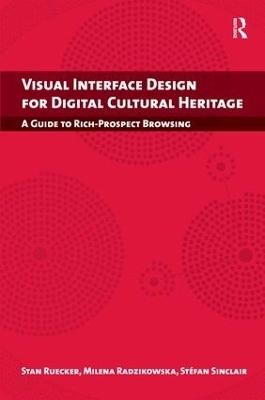
Visual Interface Design for Digital Cultural Heritage
A Guide to Rich-Prospect Browsing
Seiten
2011
Routledge (Verlag)
978-1-4094-0422-4 (ISBN)
Routledge (Verlag)
978-1-4094-0422-4 (ISBN)
- Titel z.Zt. nicht lieferbar
- Versandkostenfrei
- Auch auf Rechnung
- Artikel merken
Browsing for information with a rich-prospect interface enables a researcher to use a highly-flexible, intuitive tool to assist hypothesis formation and pattern-finding. This book discusses the interface design, with examples of how it can be done, and demonstrates its importance to all aspects of library and information science in the digital age.
Browsing for information is a significant part of most research activity, but many online collections hamper browsing with interfaces that are variants on a search box. Research shows that rich-prospect interfaces can offer an intuitive and highly flexible alternative environment for information browsing, assisting hypothesis formation and pattern-finding. This unique book offers a clear discussion of this form of interface design, including a theoretical basis for why it is important, and examples of how it can be done. It will be of interest to those working in the fields of library and information science, human-computer interaction, visual communication design, and the digital humanities as well as those interested in new theories and practices for designing web interfaces for library collections, digitized cultural heritage materials, and other types of digital collections.
Browsing for information is a significant part of most research activity, but many online collections hamper browsing with interfaces that are variants on a search box. Research shows that rich-prospect interfaces can offer an intuitive and highly flexible alternative environment for information browsing, assisting hypothesis formation and pattern-finding. This unique book offers a clear discussion of this form of interface design, including a theoretical basis for why it is important, and examples of how it can be done. It will be of interest to those working in the fields of library and information science, human-computer interaction, visual communication design, and the digital humanities as well as those interested in new theories and practices for designing web interfaces for library collections, digitized cultural heritage materials, and other types of digital collections.
Stan Ruecker is Associate Professor at Illinois Institute of Technology, USA; Milena Radzikowska is Associate Professor in the Centre for Communication Studies at Mount Royal University, Canada and Stéfan Sinclair is Associate Professor of Digital Humanities, Languages, Literatures & Cultures, McGill University, Canada
Contents: Introduction to rich-prospect interfaces; I see what I can do: affordances of prospect; Is this thing working? The study of new affordances; I never forget a face: meaningful and useful representation of items; Textual markup for digital collections; The design of new interface tools; Conclusions; References; Index.
| Erscheint lt. Verlag | 28.6.2011 |
|---|---|
| Reihe/Serie | Digital Research in the Arts and Humanities |
| Verlagsort | London |
| Sprache | englisch |
| Maße | 156 x 234 mm |
| Gewicht | 521 g |
| Themenwelt | Reisen ► Reiseführer |
| Informatik ► Software Entwicklung ► User Interfaces (HCI) | |
| Sozialwissenschaften ► Kommunikation / Medien ► Buchhandel / Bibliothekswesen | |
| Technik ► Umwelttechnik / Biotechnologie | |
| ISBN-10 | 1-4094-0422-6 / 1409404226 |
| ISBN-13 | 978-1-4094-0422-4 / 9781409404224 |
| Zustand | Neuware |
| Haben Sie eine Frage zum Produkt? |
Mehr entdecken
aus dem Bereich
aus dem Bereich
Aus- und Weiterbildung nach iSAQB-Standard zum Certified Professional …
Buch | Hardcover (2023)
dpunkt Verlag
CHF 48,85
Lean UX und Design Thinking: Teambasierte Entwicklung …
Buch | Hardcover (2022)
dpunkt (Verlag)
CHF 48,85
Wissensverarbeitung - Neuronale Netze
Buch | Hardcover (2023)
Carl Hanser (Verlag)
CHF 48,95


